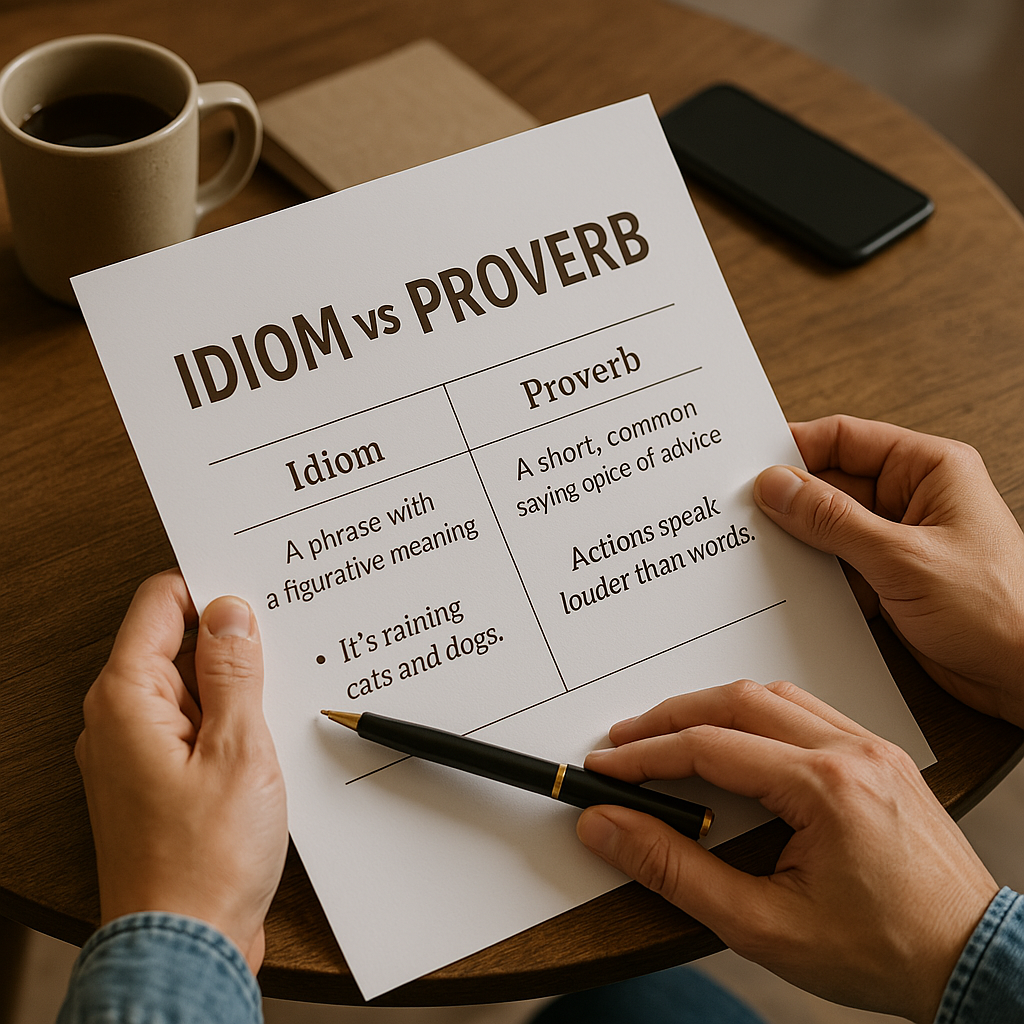Language is a powerful tool that allows us to express thoughts, emotions, and ideas. Among the many communication tools available, idioms and proverbs play a crucial role in shaping the way we convey meaning. However, many people struggle to differentiate between an idiom vs proverb and often use them interchangeably. While both are commonly used in the English language, they serve different purposes.
This article explores the key differences between idioms and proverbs, their usage in speech and writing, their cultural relevance, and how to use them effectively to enhance communication skills.
What Is an Idiom?
An idiom is a phrase or expression whose meaning cannot be deduced from the literal definitions of the individual words. Instead, idioms have a figurative meaning that is understood through common usage.
Characteristics of Idioms:
- Non-literal Meaning: Idioms often convey a meaning that is different from the sum of their words.
- Culturally Specific: Many idioms are tied to a particular culture, making them difficult to translate.
- Fixed Expressions: Idioms usually do not allow for word substitutions.
Read More About This Article: Motif vs Theme: Clarifying the Confusion in Storytelling
Examples of Common Idioms:
| Idiom | Meaning |
|---|---|
| “Break the ice” | To start a conversation in a social setting |
| “Spill the beans” | To reveal a secret |
| “Bite the bullet” | To endure a difficult situation bravely |
| “Hit the nail on the head” | To describe exactly what is happening |
What Is a Proverb?
A proverb is a short, commonly known saying that expresses general truth, wisdom, or practical advice. Unlike idioms, proverbs typically have a literal meaning that can be understood directly.
Characteristics of Proverbs:
- Teaches a Lesson: Proverbs often contain moral or practical life advice.
- Timeless Wisdom: Many proverbs have been passed down for generations.
- Universal Relevance: Proverbs exist in almost every culture, often with similar meanings.
Examples of Common Proverbs:
| Proverb | Meaning |
|---|---|
| “A stitch in time saves nine” | Taking early action prevents bigger problems later |
| “Honesty is the best policy” | Telling the truth is always the best choice |
| “The early bird catches the worm” | Being proactive leads to success |
| “Actions speak louder than words” | What you do matters more than what you say |
Key Differences Between Idioms and Proverbs
Understanding the distinction between an idiom vs proverb helps improve communication skills and ensures the correct application of these expressions.
1. Literal vs Figurative Meaning
- Idioms: Have a figurative meaning that is not immediately clear.
- Proverbs: Often have a literal meaning that conveys wisdom or advice.
2. Function in Communication
- Idioms: Enhance storytelling and writing and conversations by adding color and emotion.
- Proverbs: Provide guidance, share wisdom, and highlight cultural relevance.
3. Memorability and Usage
- Idioms: Are more difficult to understand without prior knowledge, making them less intuitive.
- Proverbs: Are easier to recall, as they often contain direct advice.
The Role of Idioms and Proverbs in the English Language
Both idioms and proverbs contribute to linguistic richness, making language more engaging and expressive. They are essential in literature, business communication, and everyday dialogue.
- Idioms: Make expressions lively and engaging in informal speech and creative writing.
- Proverbs: Are frequently used in formal settings, speeches, and persuasive writing to reinforce points.
Cultural Relevance of Idioms and Proverbs
Different cultures have unique idioms and proverbs, reflecting their history, values, and traditions. While some sayings have equivalents across languages, others are unique to specific communities.
Examples of Culturally Unique Proverbs and Idioms:
| Culture | Idiom/Proverb | Meaning |
|---|---|---|
| Chinese | “A journey of a thousand miles begins with a single step.” | Start small to achieve big goals. |
| French | “Chercher midi à quatorze heures.” | Making something more complicated than necessary. |
| Spanish | “Más vale tarde que nunca.” | Better late than never. |
| Russian | “Не имей сто рублей, а имей сто друзей.” | Having friends is more valuable than money. |
How to Use Idioms and Proverbs Effectively
To maximize their impact in speech and writing, follow these guidelines:
1. Consider the Context
- Use idioms in informal settings and storytelling.
- Use proverbs in formal discussions, motivational speaking, and advising others.
2. Understand the Audience
- Avoid using idioms with non-native speakers who may not understand the figurative language.
- Select proverbs that align with the cultural background of the audience.
3. Avoid Overuse
- Too many idioms can make speech confusing.
- Overusing proverbs can make communication sound preachy.
Common Mistakes and Misconceptions
Many learners struggle with idioms and proverbs due to their abstract nature. Here are some common mistakes to avoid:
1. Mixing Up Idioms and Proverbs
- Incorrect: “A stitch in time saves nine” is an idiom. (It’s a proverb!)
- Correct: “Spill the beans” is an idiom.
2. Taking Idioms Literally
- Incorrect: “Break a leg” means to physically harm someone.
- Correct: “Break a leg” is a way to wish someone good luck.
3. Using Proverbs in the Wrong Context
- Incorrect: Saying “The early bird catches the worm” to someone arriving late for a casual dinner.
- Correct: Using “The early bird catches the worm” in a professional setting to encourage punctuality.
Conclusion
Understanding the differences between an idiom vs proverb helps improve communication skills and allows for more effective speech and writing. Idioms enhance expressiveness through figurative language, while proverbs offer timeless wisdom with literal meanings.
By learning how to use them effectively, you can enrich your vocabulary, make your conversations more engaging, and ensure clarity in your expressions.
Do you have a favorite idiom or proverb? Share it in the comments below!
